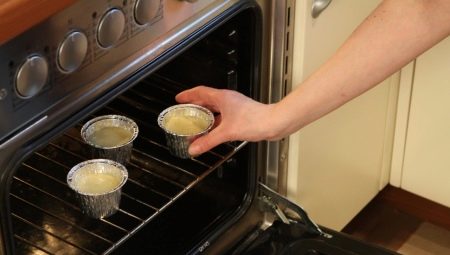Among the variety of heat-resistant cookware, foil molds occupy a special place. Currently, their popularity has declined slightly. But they are completely forgotten in vain. There are many dishes that taste perfect in the form of foil. In their defense says a large number of useful characteristics. Such an acquisition will be profitable and definitely useful in culinary business.
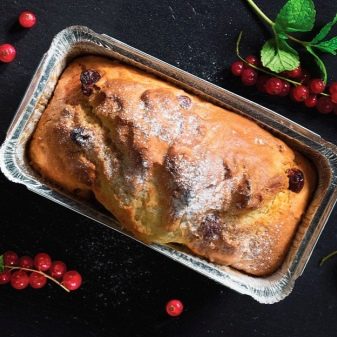
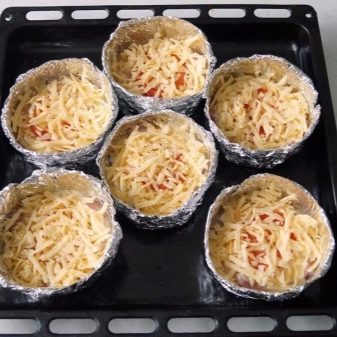
Advantages and disadvantages
Such forms are not in vain made of aluminum. Due to this, they have a lot of positive features.
- Convenience and practicality. They speed up the preparation time of products, save energy on washing, if the model is disposable.
- Multifunctionality. Due to their good thermal stability, they can not only be baked, but also frozen and stored.
- Uniform heat distribution. The dish will not burn on the edges and will not remain moist inside.
- Attractive appearance. The forms are pleasant to use, you can serve cooked dishes on the table. Such dishes help maintain the right temperature.
- Compliance with safety standards for humans, the absence of toxic substances.
- Environmental friendliness. Biodegradable material will not harm nature when disposed of.

Compared to other forms (ceramic, glass, steel or cast iron), foil foils are lighter and convenient to store. Of course, they are inferior in strength and can crumple. But they will not break when falling, like glass ones; there will be no chips on them. Aluminum foil molds are more stable and retain their shape better than silicone or paper molds. An additional plus is low cost with good quality.Most people can afford such baking dishes.
Foil products are safe for contact with food. Of course, if this does not apply to an acidic environment. In this case, the contact should be minimal in time. Even with frequent use, the ingress of aluminum into food and, accordingly, into the human body is negligible and can not cause significant harm. Moreover, a baking dish made of foil will help to make the diet more healthy, since it does not require oiling.
Cooked foods are baked in their own juice and retain all the nutrients.
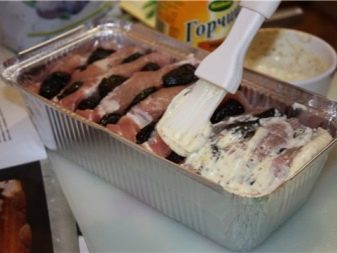

Kinds
Since there are a lot of varieties of metal forms, it should be clearly understood what a foil product is. Roughly speaking, they can be understood only as those varieties of aluminum baking dishes that were made from a sheet (by pressing). Cast aluminum cookware is a completely different kind, and its properties will vary.
Products may vary in thickness. More dense sides and the bottom give the chance of repeated use. But even reusable forms should be treated with care. In addition, the shapes can vary in size, capacity and height of the sides. Small molds are intended for cooking portioned dishes.
Usually, when buying, they pay more attention to appearance. Most often found:
- square or rectangular;
- round or oval;
- curly (in the form of a flower, heart, and so on).


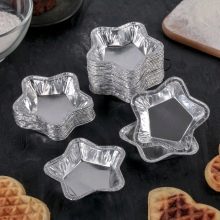
Single options are the most popular, but there are also double ones, as well as consisting of several compartments. The bottom can be smooth or embossed. The ribbed bottom in the form of a certain pattern can become a decoration of the dish, especially when it comes to confectionery. The same applies to the sides.
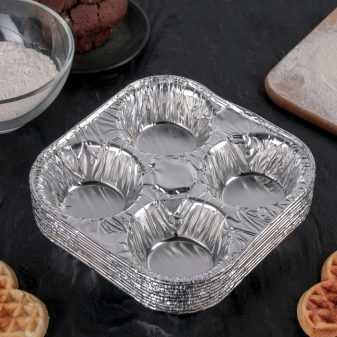
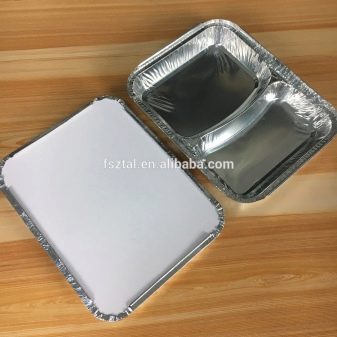
Pay attention to the edges of the forms:
- L-shaped edge usually comes in models with covers;
- The G-shaped edge is more suitable for baking, and you can cover it with a suitable sheet of ordinary foil.
It is necessary to distinguish between baking dishes and cassettes - a kind of disposable storage containers that help preserve the freshness of food. They can heat food.

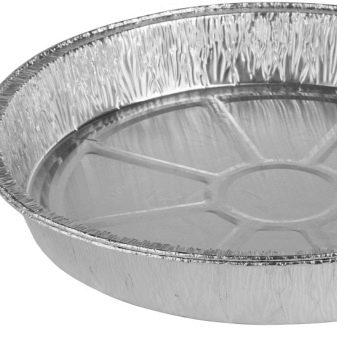
Terms of use
Foil Molds can be safely used for:
- baking bakery products;
- baking meat, fish, chicken, vegetables and fruits in the oven;
- for the preparation of cold snacks and desserts;
- storage of cooked dishes;
- transportation of any suitable food products;
- freezing and warming.
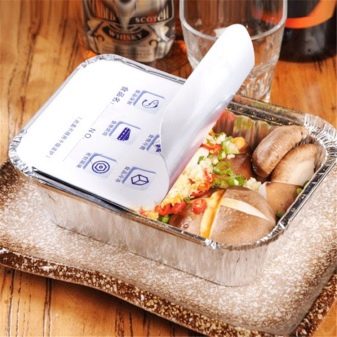
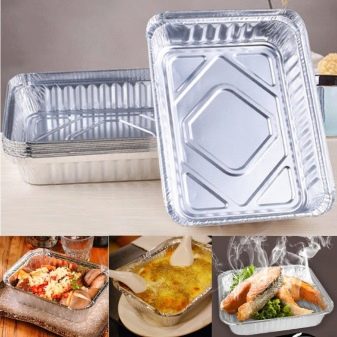
In addition to the oven, they can be used for frying on charcoal (at the same time, open fire should be avoided). There is a lot of controversy about the microwave. Manufacturers of foil containers claim that it is safe - you just need to make sure that they do not touch the walls of the microwave oven, and there is no lid.
So that the use of aluminum foil molds does not bring disappointment, several rules should be taken into account.
- Before the first use, despite the opinion that the foil has antibacterial properties, it is better to wash the product. To do this, you need a soft sponge and ordinary detergent - abrasives and hard brushes are prohibited. Before re-washing, a dirty reusable container should be soaked in warm water, then washed and dried with a towel.
- Lubricate the form is not necessary. But make sure that the temperature is optimal, and the dish does not burn out - it is necessary.
- To make the meat baked more evenly, it is better to close the form with a lid or foil. 10-15 minutes before being ready, the lid is removed and the dish is allowed to brown. Foil will help if the top is usually burnt. Hermetically sealed form will protect the oven from splashes of fat.
- Do not overheat empty dishes. Before cooking, only the oven must be preheated. Direct contact with fire may result in burns.
- Taking products out of the mold is quite simple.To do this, you can use the blades, turn the tank over or cut the sides.

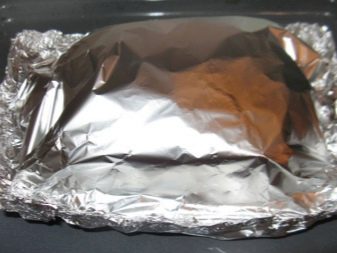
How to do it yourself?
With the purchase of aluminum foil molds there is usually no hassle. They can be purchased at any specialized store, as well as at some grocery stores. However, if necessary, a similar shape can be easily made by one’s hands using ordinary foil. It easily bends and wrinkles, but it does not tear. Of course, it is better to use thicker foil for forms, but this information is not always indicated on the package, so any will do.
So that in the process of cooking the form does not deform, it is better to use several sheets superimposed on each other.
The easiest option is to take as a basis suitable for the size and shape of dishes. In this case, you need to act in a certain way.
- Sheets are superimposed on the outside or inside of the selected container. This must be done so that the center of the bottom and sheets approximately coincide, and the same distance remains on the sides.
- Then proceed to the formation of the bottom. The stability of the structure depends on how sharp the bends are.
- After the bottom, we begin to press the sheets on the sides. As soon as this is done, the formed edges need to be cut, and the sharp edges bent.
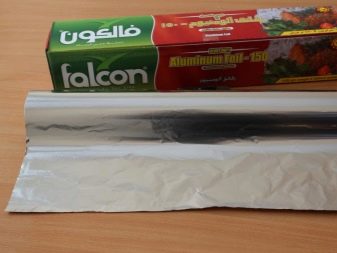

With small molds, we’re even easier. To do this, take two identical glasses without handles. We turn one of them, put a sheet of foil on top (on the bottom from the outside) and put on a second glass. Next, you just need to draw the edges.
Foil baking containers can also be formed without a solid container - just by hand. For convenience, some molds are made with handles. At the same time, the bottom does not have to be smooth - with the help of improvised means, suitable impressions can be made on it.

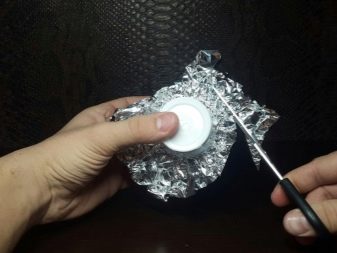
See below for how to make a baking tin foil mold.
